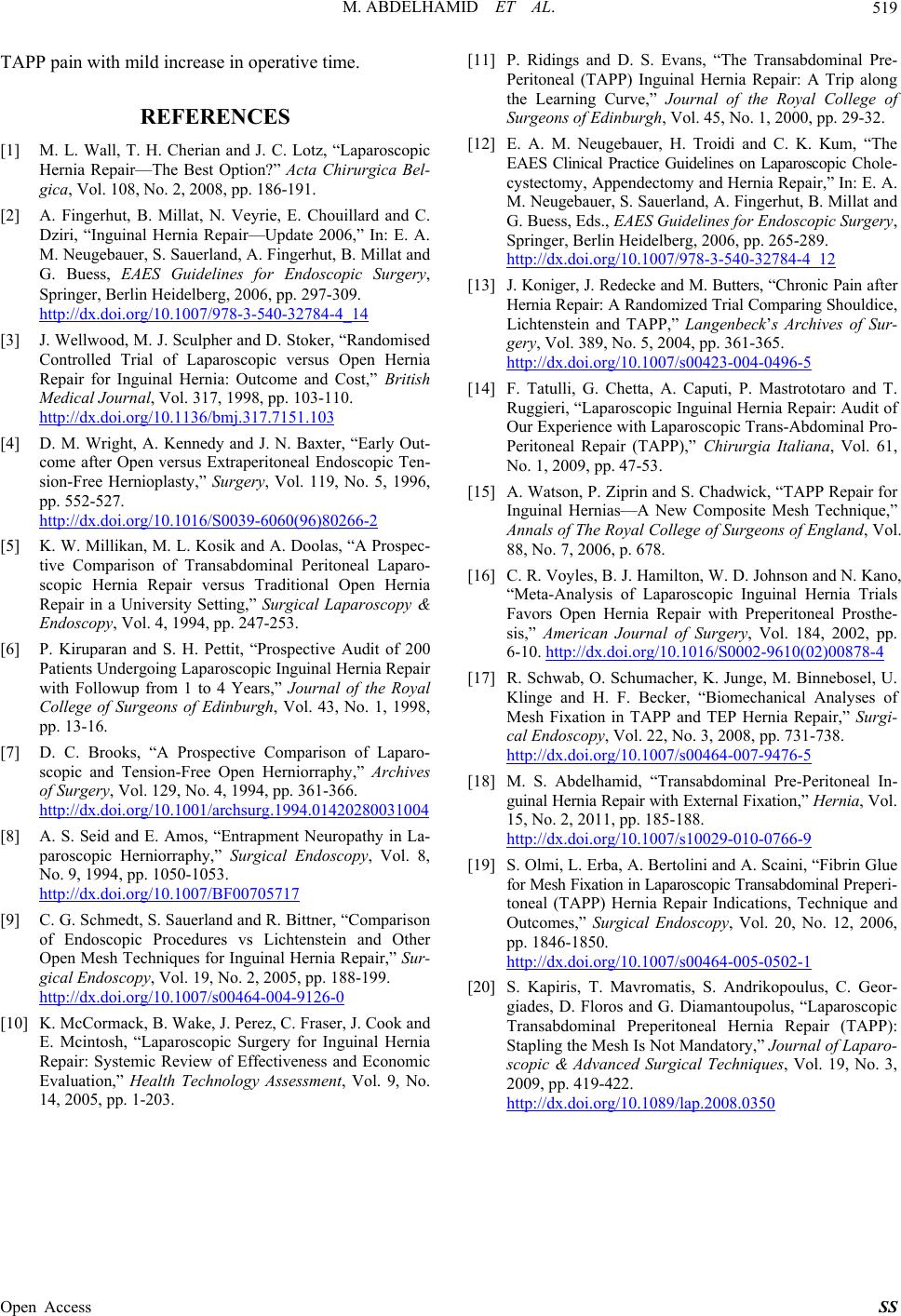
M. ABDELHAMID ET AL.
Open Access SS
519
TAPP pain with mild increase in operative time.
REFERENCES
[1] M. L. Wall, T. H. Cherian and J. C. Lotz, “Laparoscopic
Hernia Repair—The Best Option?” Acta Chirurgica Bel-
gica, Vol. 108, No. 2, 2008, pp. 186-191.
[2] A. Fingerhut, B. Millat, N. Veyrie, E. Chouillard and C.
Dziri, “Inguinal Hernia Repair—Update 2006,” In: E. A.
M. Neugebauer, S. Sauerland, A. Fingerhut, B. Millat and
G. Buess, EAES Guidelines for Endoscopic Surgery,
Springer, Berlin Heidelberg, 2006, pp. 297-309.
http://dx.doi.org/10.1007/978-3-540-32784-4_14
[3] J. Wellwood, M. J. Sculpher and D. Stoker, “Randomised
Controlled Trial of Laparoscopic versus Open Hernia
Repair for Inguinal Hernia: Outcome and Cost,” British
Medical Journal, Vol. 317, 1998, pp. 103-110.
http://dx.doi.org/10.1136/bmj.317.7151.103
[4] D. M. Wright, A. Kennedy and J. N. Baxter, “Early Out-
come after Open versus Extraperitoneal Endoscopic Ten-
sion-Free Hernioplasty,” Surgery, Vol. 119, No. 5, 1996,
pp. 552-527.
http://dx.doi.org/10.1016/S0039-6060(96)80266-2
[5] K. W. Millikan, M. L. Kosik and A. Doolas, “A Prospec-
tive Comparison of Transabdominal Peritoneal Laparo-
scopic Hernia Repair versus Traditional Open Hernia
Repair in a University Setting,” Surgical Laparoscopy &
Endoscopy, Vol. 4, 1994, pp. 247-253.
[6] P. Kiruparan and S. H. Pettit, “Prospective Audit of 200
Patients Undergoing Laparoscopic Inguinal Hernia Repair
with Followup from 1 to 4 Years,” Journal of the Royal
College of Surgeons of Edinburgh, Vol. 43, No. 1, 1998,
pp. 13-16.
[7] D. C. Brooks, “A Prospective Comparison of Laparo-
scopic and Tension-Free Open Herniorraphy,” Archives
of Surgery, Vol. 129, No. 4, 1994, pp. 361-366.
http://dx.doi.org/10.1001/archsurg.1994.01420280031004
[8] A. S. Seid and E. Amos, “Entrapment Neuropathy in La-
paroscopic Herniorraphy,” Surgical Endoscopy, Vol. 8,
No. 9, 1994, pp. 1050-1053.
http://dx.doi.org/10.1007/BF00705717
[9] C. G. Schmedt, S. Sauerland and R. Bittner, “Comparison
of Endoscopic Procedures vs Lichtenstein and Other
Open Mesh Techniques for Inguinal Hernia Repair,” Sur-
gical Endoscopy, Vol. 19, No. 2, 2005, pp. 188-199.
http://dx.doi.org/10.1007/s00464-004-9126-0
[10] K. McCormack, B. Wake, J. Perez, C. Fraser, J. Cook and
E. Mcintosh, “Laparoscopic Surgery for Inguinal Hernia
Repair: Systemic Review of Effectiveness and Economic
Evaluation,” Health Technology Assessment, Vol. 9, No.
14, 2005, pp. 1-203.
[11] P. Ridings and D. S. Evans, “The Transabdominal Pre-
Peritoneal (TAPP) Inguinal Hernia Repair: A Trip along
the Learning Curve,” Journal of the Royal College of
Surgeons of Edinburgh, Vol. 45, No. 1, 2000, pp. 29-32.
[12] E. A. M. Neugebauer, H. Troidi and C. K. Kum, “The
EAES Clinical Practice Guidelines on Laparoscopic Chole-
cystectomy, Appendectomy and He rnia Repair,” In: E. A.
M. Neugebauer, S. Sauerland, A. Fingerhut, B. Millat and
G. Buess, Eds., EAES Guidelines for Endoscopic Surgery,
Springer, Berlin Heidelberg, 2006, pp. 265-289.
http://dx.doi.org/10.1007/978-3-540-32784-4_12
[13] J. Koniger, J. Redecke and M. Bu tters, “Chronic Pain a fte r
Hernia Repair: A Randomized Trial Comparing Sh ou ld ic e,
Lichtenstein and TAPP,” Langenbeck’s Archives of Sur-
gery, Vol. 389, No. 5, 2004, pp. 361-365.
http://dx.doi.org/10.1007/s00423-004-0496-5
[14] F. Tatulli, G. Chetta, A. Caputi, P. Mastrototaro and T.
Ruggieri, “Laparoscopic Inguinal Hernia Repair: Audit of
Our Experience with Laparoscopic Trans-Abdominal Pro-
Peritoneal Repair (TAPP),” Chirurgia Italiana, Vol. 61,
No. 1, 2009, pp. 47-53.
[15] A. Watson, P. Ziprin and S. Chadwick, “TAPP Repair for
Inguinal Hernias—A New Composite Mesh Technique,”
Annals of The Royal College of Surgeons of England, Vol.
88, No. 7, 2006, p. 678.
[16] C. R. Voyles, B. J. Hamilton, W. D. Johnson and N. Kano,
“Meta-Analysis of Laparoscopic Inguinal Hernia Trials
Favors Open Hernia Repair with Preperitoneal Prosthe-
sis,” American Journal of Surgery, Vol. 184, 2002, pp.
6-10. http://dx.doi.org/10.1016/S0002-9610(02)00878-4
[17] R. Schwab, O. Schumacher, K. Junge, M. Binnebosel, U.
Klinge and H. F. Becker, “Biomechanical Analyses of
Mesh Fixation in TAPP and TEP Hernia Repair,” Surgi-
cal Endoscopy, Vol. 22, No. 3, 2008, pp. 731-738.
http://dx.doi.org/10.1007/s00464-007-9476-5
[18] M. S. Abdelhamid, “Transabdominal Pre-Peritoneal In-
guinal Hernia Repair with External Fixation,” Hernia, Vol .
15, No. 2, 2011, pp. 185-188.
http://dx.doi.org/10.1007/s10029-010-0766-9
[19] S. Olmi, L. Erba, A. Bertolini and A. Scaini, “Fibrin Glue
for Me sh Fixation in Laparo scopic Tran sabdomi nal P re p e r i -
toneal (TAPP) Hernia Repair Indications, Technique and
Outcomes,” Surgical Endoscopy, Vol. 20, No. 12, 2006,
pp. 1846-1850.
http://dx.doi.org/10.1007/s00464-005-0502-1
[20] S. Kapiris, T. Mavromatis, S. Andrikopoulus, C. Geor-
giades, D. Floros and G. Diamantoupolus, “Laparoscopic
Transabdominal Preperitoneal Hernia Repair (TAPP):
Stapling the Mesh Is Not Mandatory,” Journal of Laparo-
scopic & Advanced Surgical Techniques, Vol. 19, No. 3,
2009, pp. 419-422.
http://dx.doi.org/10.1089/lap.2008.0350